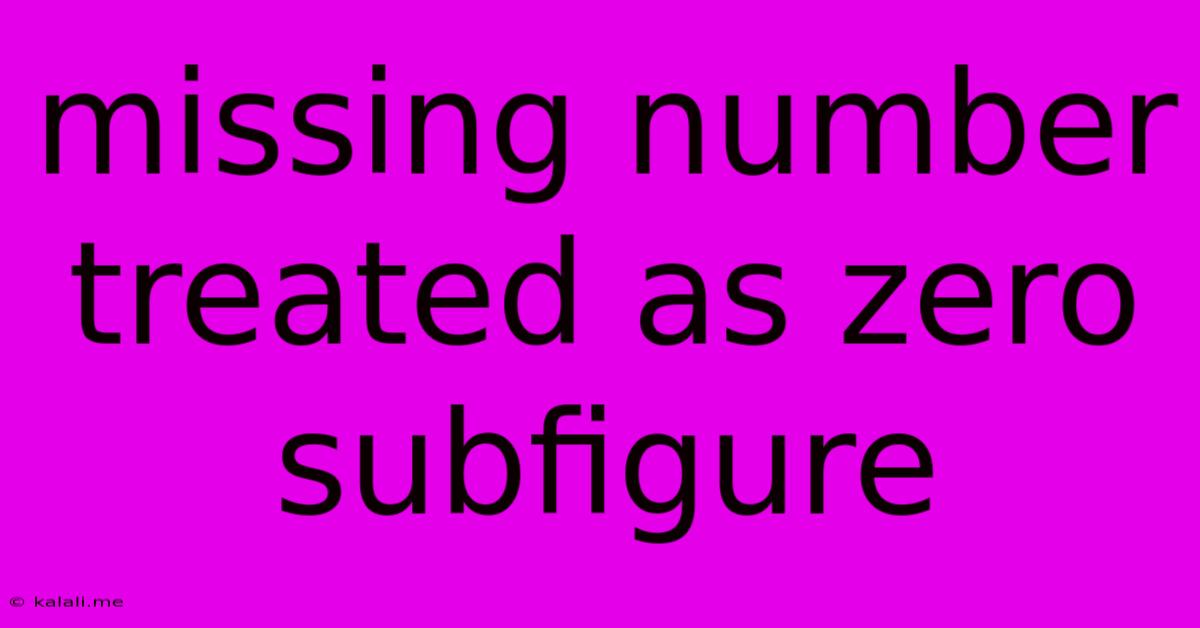Missing Number Treated As Zero Subfigure
Kalali
May 24, 2025 · 3 min read

Table of Contents
Handling Missing Numbers as Zero in Subfigures: A Comprehensive Guide
Meta Description: Learn how to effectively manage missing numerical data in subfigures, ensuring data integrity and accurate visualization. This guide covers various techniques and best practices for handling missing values, represented as zeros, within your subfigures.
Missing data is a common challenge in data visualization, especially when dealing with multiple subfigures displaying related datasets. One frequent approach is to treat missing numerical values as zero. While seemingly simple, this method requires careful consideration to avoid misinterpretations and ensure the accuracy of your visual representation. This article will explore effective strategies for handling missing numbers as zeros in subfigures, highlighting the benefits, drawbacks, and best practices.
Understanding the Implications of Treating Missing Numbers as Zero
Representing missing data as zero can significantly impact the interpretation of your subfigures. It artificially inflates the number of zero values, potentially skewing statistical analyses like mean, median, and standard deviation. This can lead to inaccurate conclusions drawn from the visualization.
Consider these points:
- Data Type: The impact of replacing missing values with zero varies depending on the data type. For continuous data (e.g., temperature, weight), this can distort the distribution. For categorical data, it might introduce a spurious category.
- Context: The context of your data is crucial. In some scenarios, zero might be a legitimate value, making this replacement appropriate. However, in other cases, a zero might represent a completely different meaning, leading to misinterpretations.
- Visualization Type: The type of subfigure used (e.g., bar chart, scatter plot, line graph) will influence how the zero values are visually represented and interpreted.
Alternative Strategies for Handling Missing Data
Before defaulting to zero imputation, explore alternative methods:
- Removal: If the number of missing values is small and doesn't significantly impact your analysis, removing the corresponding data points might be the simplest solution.
- Imputation Techniques: More sophisticated techniques like mean imputation, median imputation, or k-Nearest Neighbors (k-NN) imputation can provide more robust estimates of missing values. These methods aim to fill in the gaps based on the patterns in your existing data.
- Data Transformation: Transforming your data (e.g., using logarithmic or Box-Cox transformations) can sometimes mitigate the effects of missing values and improve the visualization's clarity.
Best Practices for Using Zero as a Placeholder
If, after considering the alternatives, you choose to represent missing numbers as zero, follow these best practices:
- Transparency: Clearly indicate in your figure caption or accompanying text that missing values are represented as zero. This ensures transparency and avoids misinterpretations by your audience.
- Visual Cues: Consider using visual cues to differentiate zero values from actual zero measurements. This could include using a different color, shading, or symbol.
- Sensitivity Analysis: Conduct a sensitivity analysis to assess the impact of using zero imputation on your conclusions. Compare the results with other imputation methods or with the data after removing missing values.
- Contextual Explanation: Provide a thorough explanation of the context surrounding your data and why you chose this method of handling missing values.
Conclusion
While replacing missing numbers with zero in subfigures might seem like a straightforward solution, it requires careful consideration. Understanding the potential implications, exploring alternative methods, and following best practices are essential for ensuring data integrity and accurate visual representation. Transparency and careful interpretation are crucial when using this technique, allowing for a reliable and informative visualization. Remember to always prioritize clarity and accuracy in your data presentation.
Latest Posts
Latest Posts
-
How To Know If Pipes Are Frozen
May 24, 2025
-
How To Get Rid Of Oil Stains On Driveway
May 24, 2025
-
How To Remove Tub Drain Plug
May 24, 2025
-
Can A Muslim Marry A Christian
May 24, 2025
-
Why Wont My Ps4 Controller Connect
May 24, 2025
Related Post
Thank you for visiting our website which covers about Missing Number Treated As Zero Subfigure . We hope the information provided has been useful to you. Feel free to contact us if you have any questions or need further assistance. See you next time and don't miss to bookmark.